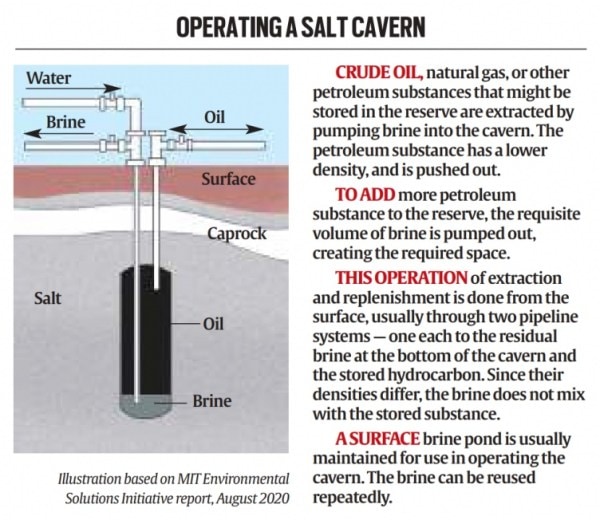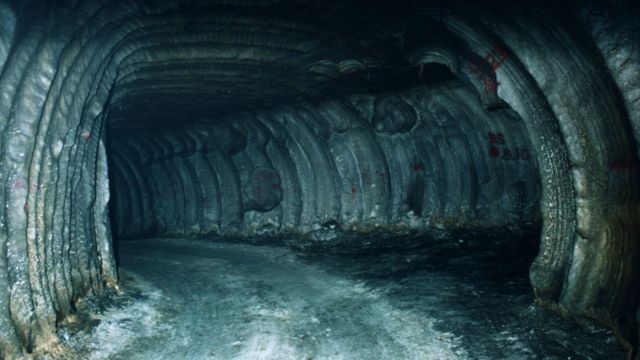SALT CAVERN-BASED STRATEGIC OIL RESERVES
1. Context
Government-owned engineering consultancy firm Engineers India (EIL) is studying the prospects and feasibility of developing salt cavern-based strategic oil reserves in Rajasthan, in line with the government’s objective of increasing the country’s strategic oil storage capacity.

2. Key takeaways
- If the idea comes to fruition, India could get its first salt cavern-based oil storage facility.
- The country’s three existing strategic oil storage facilities at Mangaluru and Padur in Karnataka and Visakhapatnam in Andhra Pradesh are made up of excavated rock caverns
- Countries build strategic crude oil reserves to mitigate major supply disruptions in the global supply chain
- India, the world’s third-largest consumer of crude, depends on imports for more than 85 per cent of its requirement and strategic petroleum reserves (SPR) could help ensure energy security and availability during global supply shocks and other emergencies
- India currently has an SPR capacity of 5.33 million tonnes, or around 39 million barrels of crude, that can meet around 9.5 days of demand
- The country is in the process of expanding its SPR capacity by a cumulative 6.5 million tonnes at two locations Chandikhol in Odisha (4 million tonnes) and Padur (2.5 million tonnes)
- India’s strategic oil reserves come under the Petroleum Ministry’s special purpose vehicle Indian Strategic Petroleum Reserve (ISPRL)
- EIL was instrumental in setting up the country’s existing SPR as the project management consultant
- Salt cavern-based storage, which is considered cheaper and less labour- and cost-intensive than rock caverns, could add a new, much-needed chapter to India’s SPR story

3. Salt Cavern based reserves vs Rock Cavern based reserves
- Unlike underground rock caverns, which are developed through excavation, salt caverns are developed by the process of solution mining, which involves pumping water into geological formations with large salt deposits to dissolve the salt
- After the brine (water with dissolved salt) is pumped out of the formation, the space can be used to store crude oil
- The process is simpler, faster, and less cost-intensive than developing excavated rock caverns
- Salt cavern-based oil storage facilities are also naturally well-sealed, and engineered for rapid injection and extraction of oil
- This makes them a more attractive option than storing oil in other geological formations, according to a report by the Environmental Solutions Initiative at the Massachusetts Institute of Technology (MIT)
- The salt that lines the inside of these caverns has extremely low oil absorbency, which creates a natural impermeable barrier against liquid and gaseous hydrocarbons, making the caverns apt for storage
- Also, unlike rock caverns, salt cavern-based storages can be created and operated almost entirely from the surface
- The entire SPR programme of the United States has so far been based on salt cavern-based storage facilities
- The US Strategic Petroleum Reserve, the world’s largest emergency oil storage, consists of four sites with deep underground storage caverns created in salt domes along the Gulf of Mexico coast in Texas and Louisiana
- The US strategic oil reserves have a cumulative capacity of around 727 million barrels
- Salt caverns are also used to store liquid fuels and natural gas in various parts of the world. They are also considered suitable for storing compressed air and hydrogen
4. India's Potential in storing crude, petroleum products
- Rajasthan, which has the bulk of requisite salt formations in India, is seen as the most conducive for developing salt cavern-based strategic storage facilities
- Plans over the past decade to build a strategic oil reserve in Bikaner did not take off and EIL’s Chairman and Managing Director Vartika Shukla said the exploration of the possibility of salt cavern-based strategic storage in Rajasthan can be seen as a renewal of that proposal
- A refinery is coming up in Barmer, and Rajasthan has crude pipelines as well; such infrastructure is conducive to building strategic oil reserves
- However, no Indian company, including EIL, had the requisite technical know-how to build salt cavern-based strategic hydrocarbon storage
- This gap in access to technology has been bridged by EIL’s recent partnership with Germany’s DEEP
5. Strategic petroleum reserves
- India’s strategic oil reserves are part of the effort to build sufficient emergency stockpiles on the lines of the reserves that the US and its Western allies set up after the first oil crisis of the 1970s
- The three existing rock cavern-based facilities were built during the first phase of the programme
- Crude oil from the reserves is to be released by an empowered committee set up by the government, in the event of supply disruptions due to a natural calamity or an unforeseen global event leading to an abnormal increase in prices
- The International Energy Agency (IEA), a Paris-based autonomous intergovernmental organisation in which India is an ‘Association’ country, recommends that all countries should hold an emergency oil stockpile sufficient to provide 90 days of import protection
- In India, apart from the SPR that is sufficient to meet 9.5 days of oil requirement, the oil marketing companies (OMCs) have storage facilities for crude oil and petroleum products for 64.5 days which means there is sufficient storage to meet around 74 days of the country’s petroleum demand
- India has also decided to commercialise its strategic petroleum reserves, as part of which the Abu Dhabi National Oil Company (ADNOC) stored about 0.8 million tonnes of crude oil in the Mangaluru strategic reserve
- In the second phase of the programme, the government wants to develop strategic reserves through public-private partnerships so as to reduce government spending and exploit the commercial potential of the reserves
- Taking advantage of low crude oil prices in April-May 2020, the government completely filled these reserves, leading to estimated savings of around Rs 5,000 crore
- In late 2021, India released 5 million barrels from its strategic reserves as part of a coordinated US-led action by major oil-consuming countries against the joint decision of major oil-producing nations to curb output
|
For Prelims: Salt Cavern oil-based reserve advantages, Rock cavern oil-based reserves, Rock cavern oil-based reserves locations
For Mains: 1. A robust recovery in domestic demand for fuel and other petroleum products amid flat domestic crude output has led to India’s dependency on imported crude. Discuss (250 Words)
|
Source: indianexpress




